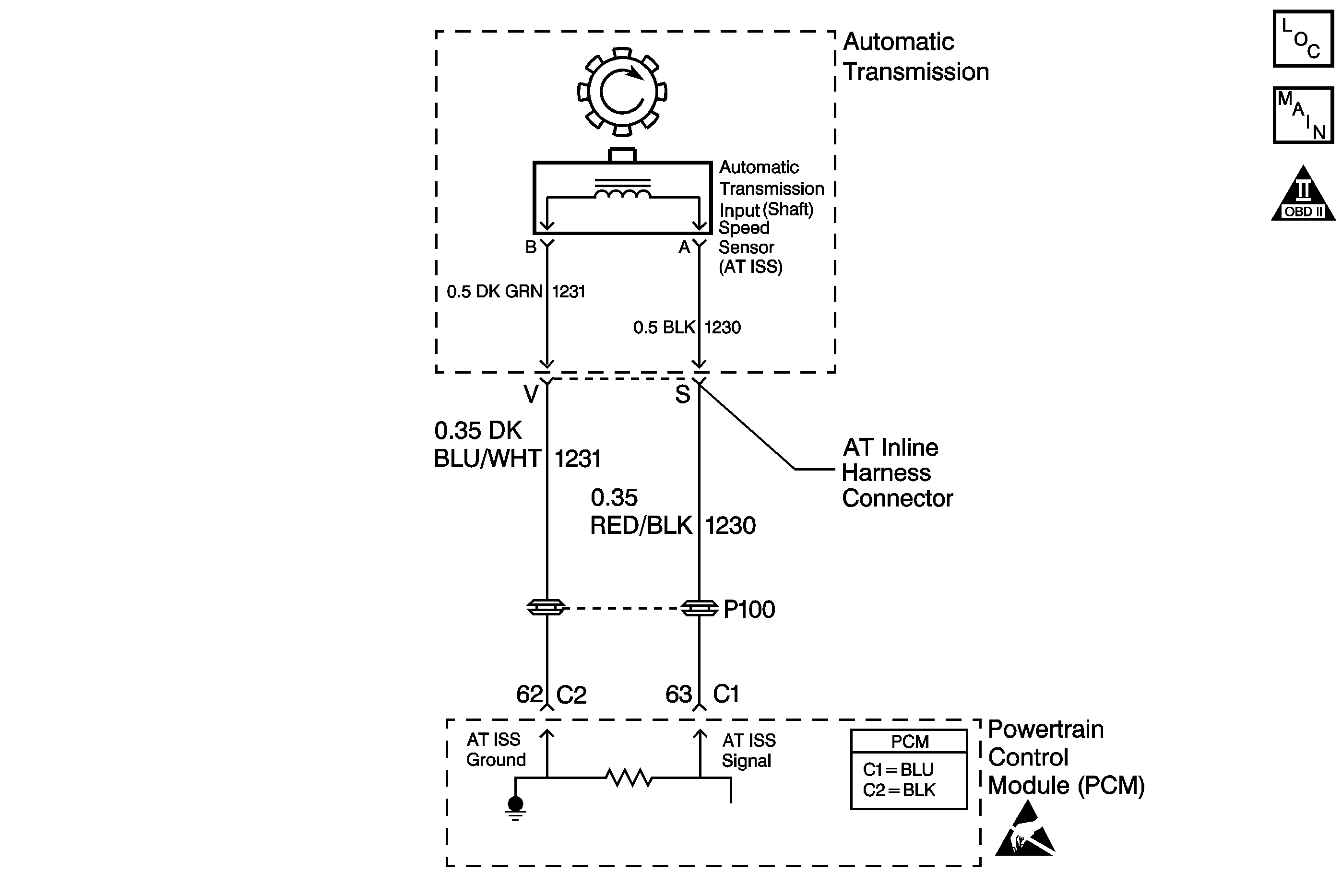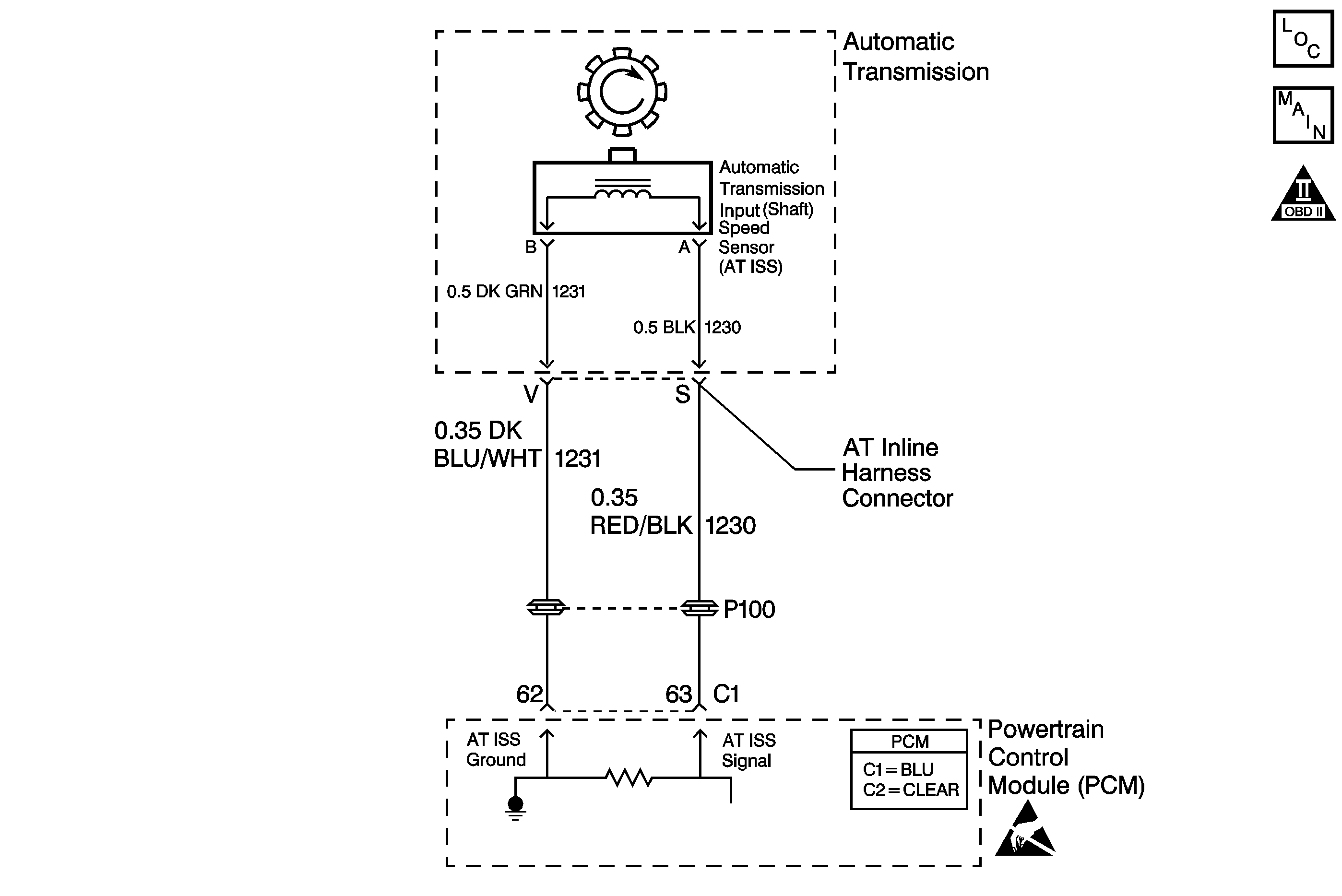DTC P0717 Input Speed Sensor Circuit Low Input 2.4L

Circuit Description
The automatic transmission input (shaft) speed sensor (AT ISS) provides transmission input speed to the PCM. The AT ISS is a permanent magnet (PM) generator. The sensor mounts into the transmission case and maintains a slight air gap between the sensor and the drive sprocket. The PM generator produces an AC voltage as the drive sprocket rotor teeth pass through the sensor's magnetic field. The AC voltage level increases as the turbine shaft speed increases. The PCM converts the AC voltage into a digital signal. The PCM determines actual turbine speed using the digital signal. The PCM uses the input speed to calculate torque converter slip speed, and gear ratios.
When the PCM detects a low input speed and the vehicle has a large vehicle speed, then DTC P0717 sets. DTC P0717 is a type B DTC.
Conditions for Running the DTC
| • | No VSS DTCs P0502 or P0503. |
| • | No TFP manual valve position switch DTC P1810. |
| • | The engine is running. |
| • | The TFP manual valve position switch indicates the vehicle is not in PARK or NEUTRAL. |
| • | The vehicle speed is greater than 8 km/h (5 mph). |
Conditions for Setting the DTC
The input speed is less than 100 RPM for 5 seconds.
Action Taken When the DTC Sets
| • | The PCM illuminates the malfunction indicator lamp (MIL) during the second consecutive trip in which the Conditions for Setting the DTC are met. |
| • | The PCM commands maximum line pressure. |
| • | The PCM freezes shift adapts from being updated. |
| • | The PCM records the operating conditions when the Conditions for Setting the DTC are met. The PCM stores this information as Freeze Frame and Failure Records. |
| • | The PCM stores DTC P0717 in PCM history during the second consecutive trip in which the Conditions for Setting the DTC are met. |
Conditions for Clearing the MIL/DTC
| • | The PCM turns OFF the MIL during the third consecutive trip in which the diagnostic test runs and passes. |
| • | A scan tool can clear the MIL/DTC. |
| • | The PCM clears the DTC from PCM history if the vehicle completes 40 warm-up cycles without an emission-related diagnostic fault occurring. |
| • | The PCM cancels the DTC default actions when the fault no longer exists and/or the ignition switch is OFF long enough in order to power down the PCM. |
Diagnostic Aids
| • | Inspect the connectors at the PCM, the AT ISS and all other circuit connecting points for an intermittent condition. Refer to Testing for Intermittent Conditions and Poor Connections in Wiring Systems. |
| • | Inspect the circuit wiring for an intermittent condition. Refer to Testing for Electrical Intermittents in Wiring Systems. |
| • | Ensure the wiring harness is not stretched too tightly or other components are pressing on the connector body. Also, inspect for proper clearance to any other components and wiring. Refer to Testing for Intermittent Conditions and Poor Connections in Wiring Systems. |
Test Description
The numbers below refer to the step numbers on the diagnostic table.
-
This step tests the AT ISS for correct resistance.
-
Replace the PCM only after you have completed the preceding diagnostic steps.
Step | Action | Value(s) | Yes | No | ||||||
|---|---|---|---|---|---|---|---|---|---|---|
1 | Did you perform the Powertrain Diagnostic System Check ? | -- | ||||||||
2 |
Important: Before clearing the DTC, use the Scan Tool in order to record the Freeze Frame and Failure Records. Using the Clear Info function erases the Freeze Frame and Failure Records from the PCM. Is the transmission input speed greater than the specified value? | 500 RPM | Go to Diagnostic Aids | |||||||
Refer to Automatic Transmission Inline Harness Connector End View . Is the resistance within the specified range? | 615-835 ohms | |||||||||
4 | Test the signal circuit (CKT 1230) of the AT ISS for an open or short to ground between the AT inline 20-way connector and the AT ISS. Refer to Circuit Testing in Wiring Systems. Did you find a condition? | -- | ||||||||
5 | Test the ground circuit (CKT 1231) of the AT ISS for an open between the AT inline 20-way connector and the AT ISS. Refer to Circuit Testing in Wiring Systems. Did you find the condition? | -- | ||||||||
6 | Test the signal circuit (CKT 1230) of the AT ISS for an open or short to ground between the PCM connector C1 and the AT inline 20-way connector. Refer to Circuit Testing and Wiring Repairs in Wiring Systems. Did you find and correct a condition? | -- | ||||||||
7 | Test the ground circuit (CKT 1231) of the AT ISS for an open between the PCM connector C2 and the AT inline 20-way connector. Refer to Circuit Testing and Wiring Repairs in Wiring Systems. Did you find and correct the condition? | -- | ||||||||
8 | Replace the automatic transmission wiring harness. Refer to Transmission Overhaul in the 4T40-E/4T45-E section of the Transmission Unit Repair Manual. Did you complete the replacement? | -- | -- | |||||||
9 | Replace the AT ISS. Refer to Transmission Overhaul in the 4T40-E/4T45-E section of the Transmission Unit Repair Manual. Did you complete the replacement? | -- | -- | |||||||
Replace the PCM. Refer to Powertrain Control Module Replacement/Programming in Engine Controls. Is the replacement complete? Did you complete the replacement? | -- | -- | ||||||||
11 | Perform the following procedure in order to verify the repair:
Has the test run and passed? | -- | System OK |
DTC P0717 Input Speed Sensor Circuit Low Input 3.4L

Circuit Description
The automatic transmission input (shaft) speed sensor (AT ISS) provides transmission input speed to the PCM. The AT ISS is a permanent magnet (PM) generator. The sensor mounts into the transmission case and maintains a slight air gap between the sensor and the drive sprocket. The PM generator produces an AC voltage as the drive sprocket rotor teeth pass through the sensor's magnetic field. The AC voltage level increases as the turbine shaft speed increases. The PCM converts the AC voltage into a digital signal. The PCM determines actual turbine speed using the digital signal. The PCM uses the input speed to calculate torque converter slip speed, and gear ratios.
When the PCM detects a low input speed and the vehicle has a large vehicle speed, then DTC P0717 sets. DTC P0717 is a type B DTC.
Conditions for Running the DTC
| • | No VSS DTCs P0502 or P0503. |
| • | No TFP manual valve position switch DTC P1810. |
| • | The engine is running. |
| • | The TFP manual valve position switch indicates the vehicle is not in PARK or NEUTRAL. |
| • | The vehicle speed is greater than 8 km/h (5 mph). |
Conditions for Setting the DTC
The input speed is less than 100 RPM for 5 seconds.
Action Taken When the DTC Sets
| • | The PCM illuminates the malfunction indicator lamp (MIL) during the second consecutive trip in which the Conditions for Setting the DTC are met. |
| • | The PCM commands maximum line pressure. |
| • | The PCM freezes shift adapts from being updated. |
| • | The PCM records the operating conditions when the Conditions for Setting the DTC are met. The PCM stores this information as Freeze Frame and Failure Records. |
| • | The PCM stores DTC P0717 in PCM history during the second consecutive trip in which the Conditions for Setting the DTC are met. |
Conditions for Clearing the MIL/DTC
| • | The PCM turns OFF the MIL during the third consecutive trip in which the diagnostic test runs and passes. |
| • | A scan tool can clear the MIL/DTC. |
| • | The PCM clears the DTC from PCM history if the vehicle completes 40 warm-up cycles without an emission-related diagnostic fault occurring. |
| • | The PCM cancels the DTC default actions when the fault no longer exists and/or the ignition switch is OFF long enough in order to power down the PCM. |
Diagnostic Aids
| • | Inspect the connectors at the PCM, the AT ISS and all other circuit connecting points for an intermittent condition. Refer to Testing for Intermittent Conditions and Poor Connections in Wiring Systems. |
| • | Inspect the circuit wiring for an intermittent condition. Refer to Testing for Electrical Intermittents in Wiring Systems. |
| • | Ensure the wiring harness is not stretched too tightly or other components are pressing on the connector body. Also, inspect for proper clearance to any other components and wiring. Refer to Testing for Intermittent Conditions and Poor Connections in Wiring Systems. |
Test Description
The numbers below refer to the step numbers on the diagnostic table.
-
This step tests the AT ISS for correct resistance.
-
Replace the PCM only after you have completed the preceding diagnostic steps.
Step | Action | Value(s) | Yes | No | ||||||
|---|---|---|---|---|---|---|---|---|---|---|
1 | Did you perform the Powertrain Diagnostic System Check ? | -- | ||||||||
2 |
Important: Before clearing the DTC, use the Scan Tool in order to record the Freeze Frame and Failure Records. Using the Clear Info function erases the Freeze Frame and Failure Records from the PCM. Is the transmission input speed greater than the specified value? | 500 RPM | Go to Diagnostic Aids | |||||||
Refer to Automatic Transmission Inline Harness Connector End View . Is the resistance within the specified range? | 615-835 ohms | |||||||||
4 | Test the signal circuit (CKT 1230) of the AT ISS for an open or short to ground between the AT inline 20-way connector and the AT ISS. Refer to Circuit Testing in Wiring Systems. Did you find a condition? | -- | ||||||||
5 | Test the ground circuit (CKT 1231) of the AT ISS for an open between the AT inline 20-way connector and the AT ISS. Refer to Circuit Testing in Wiring Systems. Did you find the condition? | -- | ||||||||
6 | Test the signal circuit (CKT 1230) of the AT ISS for an open or short to ground between the PCM connector C1 and the AT inline 20-way connector. Refer to Circuit Testing and Wiring Repairs in Wiring Systems. Did you find and correct a condition? | -- | ||||||||
7 | Test the ground circuit (CKT 1231) of the AT ISS for an open between the PCM connector C1 and the AT inline 20-way connector. Refer to Circuit Testing and Wiring Repairs in Wiring Systems. Did you find and correct the condition? | -- | ||||||||
8 | Replace the automatic transmission wiring harness. Refer to Transmission Overhaul in the 4T40-E/4T45-E section of the Transmission Unit Repair Manual. Did you complete the replacement? | -- | -- | |||||||
9 | Replace the AT ISS. Refer to Transmission Overhaul in the 4T40-E/4T45-E section of the Transmission Unit Repair Manual. Did you complete the replacement? | -- | -- | |||||||
Replace the PCM. Refer to Powertrain Control Module Replacement/Programming in Engine Controls. Is the replacement complete? Did you complete the replacement? | -- | -- | ||||||||
11 | Perform the following procedure in order to verify the repair:
Has the test run and passed? | -- | System OK |
